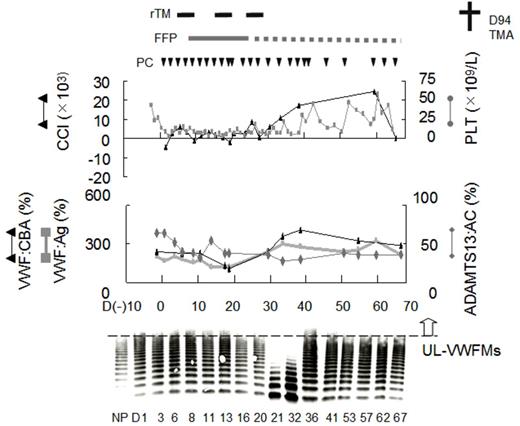Abstract
Hepatic veno-occlusive disease (VOD) associated with hematopoietic stem cell transplantation (HSCT) is characterized by a clinical triad of jaundice (total bilirubin, >2 mg/mL), hepatomegaly with right upper quadrant pain, and ascites and/or unexplained body weight gain (>5% of baseline) within 30 days after operation. Although the pathogenesis of hepatic VOD has not been fully elucidated, the common pathological features are thrombi formed in hepatic central vein.
We previously reported that a significant decrease of plasma ADAMTS13 activity was noted in patients undergoing HSCT, who subsequently developed VOD (Park et al, BMT 2002). Then, we showed that plasma antigen levels of von Willebrand factor (VWF) has been kept higher in HSCT-patients with VOD than in those without, and in fact prophylactic infusions of fresh frozen plasma (FFP) with a dose of 10 ml/kg body weight 3 times per week were effective to reduce the frequency of VOD occurrence in high risk patients (Matsumoto et al, BMT 2007). However, more recent studies by ours indicate that FFP infusion alone is not enough to totally eliminate the occurrence (unpublished). Recently, it has been shown that the treatment with recombinant soluble thrombomodulin (rTM) is sometimes highly efficient to reverse VOD progression. But its pharmacokinetics and regimen for the treatment has not been established. As a first step to elucidate a possible combination regimen of FFP and rTM to VOD patients, here we have analyzed the transitional changes of unusually large VWF multimers (UL-VWFMs). The UL-VWFMs are released from damaged endothelial cells and induce platelet hyperagglutination under high shear stress generated in microvasculatures, and are often observed in patient plasmas undergoing HSCT.
During 2011-2012, 45 patients were received allogenic HSCT in the second internal medicine department of our university hospital. None of these patients ,however, were received planned prophylactic FFP infusions, and as a result six patients undergoing allogenic cord blood transplantation (CBT) developed VOD. Clinical features of these 6 patients are shown in Table 1.
Under approval of Ethics Committee of Nara Medical University, we consecutively collected patient's citrated plasmas (ca 2.5 ml) and stored at -80°C until use. Using these deep-frozen plasma samples, we here extensively analyzed plasma levels of ADAMTS13 activity (ADAMTS13:AC), VWF antigen (VWF:Ag), and VWF collagen binding activity (VWF: CBA), together with VWF multimer analysis. More importantly, we also measured the corrected platelet count increment (CCI) to evaluate the efficiency of Platelet trsnsfusions. Then, we comprehensively evaluated these data with routine clinical and laboratory findings.
1) Plasma levels of ADAMTS13:AC were moderately but consistently decreased during two months after HSCT, whereas those of VWF:Ag were kept high, usually more than 200% and often 500% of the normal. 2) The UL-VWFMs appeared soon after HSCT, and continued at least until absolute neutrophil count (ANC) increased to >500 (usually 20-30 days after HSCT). 3) Until platelet engraftment (usually 40-60 days after HSCT), platelet transfusions (every 2-3 days interval) are usually performed to prevent the bleeding complications. During that period, the CCI values were consistently low, but those values were significantly increased during the administration of rTM. 4) Excess platelet transfusions before platelet engraftment induced the consumption of larger VWFMs in patient's plasmas, and often almost simultaneously hepatic VOD developed. Thus, platelet transfusions during the appearance of UL-VWFMs in patient's plasmas may induce platelet clumping in microvasculatures, and lead to the development of thrombotic complications including hepatic VOD. 5) The measurement of plasma levels of VWF:CB activity appeared to well predict the presence of UL-VWFMs. A representative case is shown in Figure.
Thus, a combination regimen of FFP and rTM might be advisable when the patients show the early clinical signs of hepatic VOD and the laboratory data such as VWF:CBA suggest the presence of UL-VWFMs in patient's plasmas.
Matsumoto:Alexion Pharma: Membership on an entity’s Board of Directors or advisory committees. Fujimura:Alexion Pharma: Membership on an entity’s Board of Directors or advisory committees; Baxter International Inc: Membership on an entity’s Board of Directors or advisory committees.
Author notes
Asterisk with author names denotes non-ASH members.



